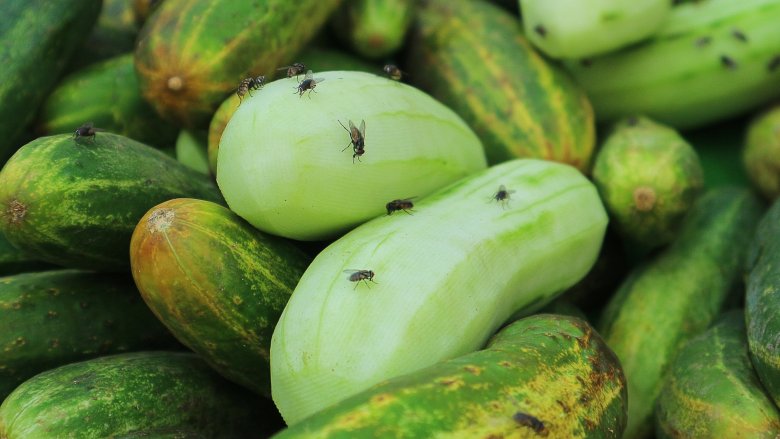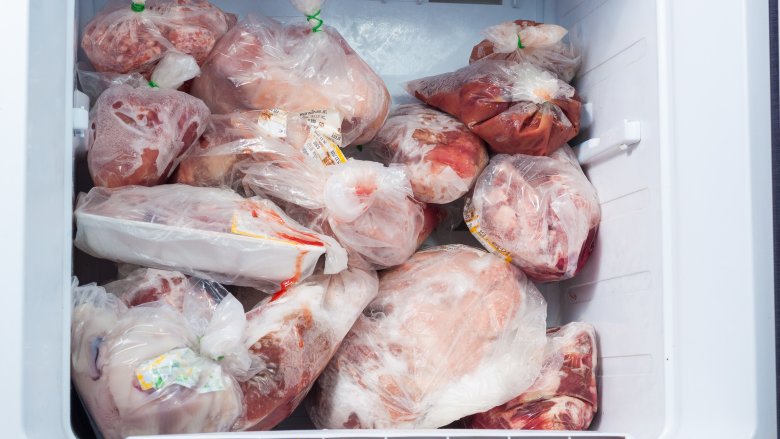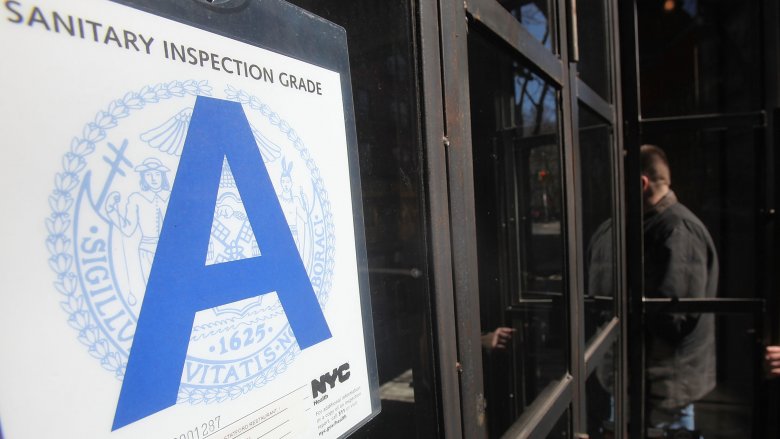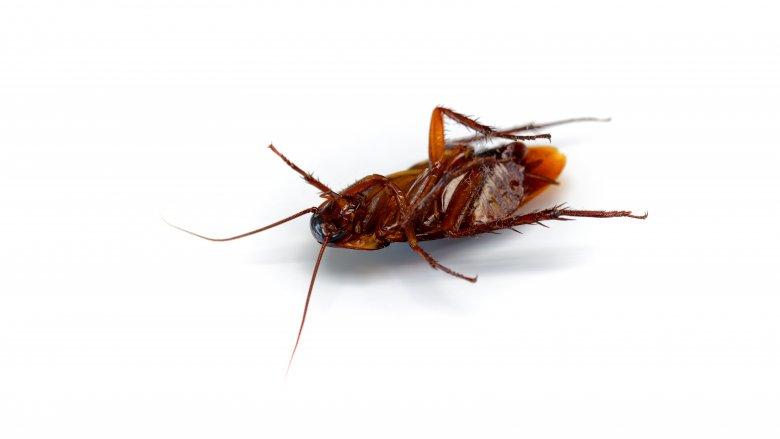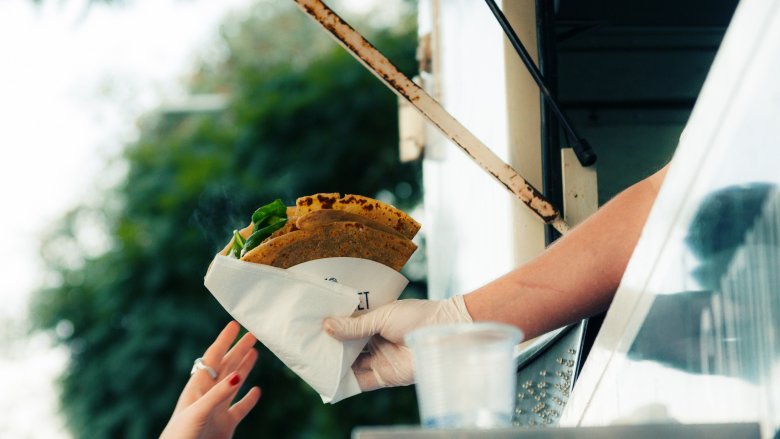Here's How You Know You're At A Bad Food Truck
It's safe to say at this point that food trucks are here to stay. What was once a novelty has now become the norm — you'll find them at "rodeos," on city street corners, and in the occasional parking lot. They're serving up everything from brick-oven pizza to Tex-Mex and more. They're typically quick and convenient, and they're undeniably trendy. So, in other words, you gotta get you some. But are they really safe? How do you know if you're at a bad food truck?
Because food trucks are governed differently than brick-and-mortar restaurants, it isn't always as easy to determine whether the food truck you're eating out of is on top of their health-and-hygiene game. Don't worry, though; that definitely doesn't mean you can't or shouldn't chow down on food truck fare whenever you get the chance. What a sad world it would be if you avoided them altogether, right?
If you want to keep living your best food truck foodie life, all you really need to do is be observant. The next time you sidle up to a mobile eatery, look for the following signs of a subpar food truck situation.
They can't produce a license
First things first — if you have a bad feeling about a food truck when you approach it, there's a super-simple way to gauge if they've got their stuff together: Ask to see their license. According to CNN, Christie Sweitz — the interim supervisor for inspection in Portland, Oregon — says that all food trucks are required by law to have one of these bad boys in hand before hitting the road. Chances are if they don't have one (and are therefore operating illegally), they're not going to stress over things like food safety regulations either.
And while asking to see a food truck's license probably isn't common practice, it is a right you shouldn't be ashamed to exercise. "You can actually ask to see the license," Sarah Klein, food safety expert at the Center for the Science in Public Interest, told CNN in 2013. "If they can't produce it, find another place to eat and call the local health department."
Would it be unfortunate if your favorite local food truck couldn't come up with anything but excuses when asked for a license? Sure. But you know what would be even more unfortunate? Winding up with food poisoning after scarfing down a dish prepared in unsanitary conditions. You can't be too safe when it comes to what you consume.
It's super-hot, and food is sitting out
In 2016, the Journal-News launched an investigation. After combing over food truck inspection reports for a year, they found "no serious, chronic violations or illnesses" that health officials could trace back to food truck fare. However, they did turn up isolated incidents of undesirable conditions inside food trucks. One of the repeat issues that turned up? Temperature regulation.
This is problematic for a few reasons. Namely, some foods are more prone to causing foodborne illnesses than others and, per the Center for Disease Control, need to be refrigerated at 40-degrees or colder to minimize the risk of issues with salmonella and other bacteria (think poultry, soft cheeses, eggs, seafood, and sprouts!).
Plus, food trucks are basically big metal boxes, often parked on hot blacktop. If it's hot outside, you can bet that the truck's A/C is working overtime to keep the truck cool — and there's a good chance it's losing the battle. So, if you decide to eat at a food truck on a sweltering day, glance inside at the countertops to make sure food isn't sitting out and overheating.
Raw meats are mingling
Because meat comes from animals that carry bacteria, the proper handling and storage of meats on a food truck is especially important. Food trucks that fail to take a few precautions are setting themselves up for cross-contamination and, worse, sending customers away with foodborne illness. When you're on the receiving end as the customer, this clearly isn't something you want to be included in your order.
But it does happen. As one example, during a routine food truck inspection in Butler County Ohio in 2016, the inspector found an area food truck had committed a critical violation — storing raw chicken above raw beef. Per the Journal-News, the inspector explained that when stored in a cooling unit, the food truck should have stored "raw animal products in order of their required cooking temperatures to prevent contamination." And, per Food Truck Food Safety Training, food truck owners should keep raw meats separate from other food starting with their grocery cart when they purchase the meat.
What does this mean for you? Well, if you're planning to indulge your carnivorous tendencies at a local food truck, you'll need to keep your eyes peeled. If you notice raw chicken stored above raw beef — or any raw meat mingling with anything else, for that matter — do your tummy a favor and seek lunch from another mobile eatery.
Your hot foot gets served cold (or vice versa)
Temperature has a ton to do with food safety — this point can't be underscored enough. The CDC mandates very specific temperature monitoring requirements for some foods, due to the fact that these foods are more associated with foodborne illnesses and incidences of food poisoning than other foods. Mobile-Cuisine, the digital food-truck bible, describes monitoring proper food temperature in a food truck as a "constant process." Accordingly, they recommend food trucks having several good thermometers on hand for staff to use while preparing food.
So, there's something you, the consumer, can look for. As you're waiting in line for your food truck order, observe the flurry of activity inside the mobile restaurant as much as possible. Even one glimpse of a food thermometer should help put your mind at ease.
Aside from that, though, determining if food temperature monitoring protocol has been followed could be more tactile — though of course, it's less exact. As in, you'll be able to tell simply by touching your food. "Temperature problems are one of the most common violations in food trucks," Dr. Jonathan Fielding, director of public health for Los Angeles County, told CNN in 2013, noting that things like deli sandwiches and salads should feel refrigerator-cold, while soups, burgers and other cooked foods should be "piping hot."
Besides, food that isn't served at its correct temperature isn't going to taste as good. A cold grilled cheese? No thank you.
No one is wearing gloves
The fact that any food service workers should wear gloves seems self-explanatory. Yet, even food truck operators have admitted to not using gloves while preparing food — one such food truck owner told Mobile-Cuisine that they had received health inspection violations because his line cook was seen buttering a sandwich and preparing other food with bare hands. Not surprisingly, Mobile-Cuisine lays out a solid argument for why food truck employees should be trained in proper glove use.
The LA Times looked into health truck safety in 2016, pointing to specific issues involving gloves (or the lack thereof). In March, they revealed, a popular food truck by the name of Tacos Ariza had earned a less-than-stellar "C" on their health inspection. Why? Health inspectors cited 16 violations, including three major infractions — including at least one due to employees not using gloves properly.
It's worth noting, though, that the FDA apparently only requires a "barrier" between food truck workers and the food they are preparing. This could be gloves, sure. But it could also be parchment paper or even utensils — so a lack of gloves doesn't automatically mean rules are being broken. But bottom line, there shouldn't be a bunch of bare-hand-on-food action going on in any given food truck. If there is, find another plan for lunch.
There are unappetizing smells
Let's be real; no one wants to stroll up to a food truck with a funky odor. If the food truck smells like anything other than food, it should make you wonder why. Is there spoiled food causing a stink? Could rotting meat be the culprit? Does the food truck stink of garbage? All of these things would suggest the food truck has sanitation issues, which is a glaring red flag that their food might not be your smartest choice.
A spoiled milk smell probably means that the food truck has refrigeration issues, or that they aren't taking the proper measures to store dairy products in the refrigerator between uses. Same goes for rotting meat, a smell which will continue to haunt your nostrils long after you leave it. Improper food cooling and storage will both earn infractions on a food truck's inspection reports.
As for a garbage odor, look around. Do you see a trash can near the food truck? Is it overflowing? A food truck should be able to stay on top of solid waste to a degree that garbage doesn't become a smelly issue. At the Virginia Tech campus, for example, food safety officials mandate that food trucks must remove trash at the end of each shift. If you approach a food truck with an overflowing bin, you should ask yourself if they're really taking it out as often as they should be. And if they're not doing that, what else are they slacking on?
Their grade isn't "A"
It's easy to take for granted the comfort that comes with seeing a big, shiny "A" plastered on the wall or in the window of a brick-and-mortar restaurant. That single letter lets us know that the restaurant is doing everything it needs to do to impress health officials. And while it would be a logical way to gauge food truck safety too, not all states require food trucks to display health inspection grades. Per CNN, "only a handful of places" mandate as much.
Still, this practice seems to be trending upward in the food truck world. New York rolled out food truck grades in January 2019, explaining to ABC 7 of the decision, "Now customers will be able to see, before deciding to eat at a food cart, how it performed at its health inspection."
Wondering what grade you should shoot for when choosing a food truck? If you ask Sarah Klein, a food-safety expert at the Center for the Science in the Public Interest, anything less than an A isn't good enough. "I'd feel uneasy about eating at a truck with a B grade because it could have violations like not keeping food at the right temperature or having no soap. And I would never eat at a truck with a C because that's close to being shut down," she told CNN in 2016.
The sinks are messy (or there's only one)
Did you know that food trucks should always have more than one sink basin? Per the New York City health department, there are certain basic equipment needs that must be met before a food truck can go into business. This includes both a sink for washing food and cooking tools and a sink for washing hands. The culinary sink should only be used for preparing food. The handwash sink should only be used for washing your hands. The culinary sink, the health department elaborates, is typically a three-compartment sink.
Tiger Chef, an online resource for commercial culinary needs, also specifies the need for separate sinks on food trucks. "Most city and state health and safety regulations require a three-compartment sink and hand sink with hot running water on all food trucks," the site states.
Let's say you're in line at a food truck and happen to catch a glimpse of a worker washing their hands. A good sign, right? Well, only if they washed their hands in the handwash sink — and that sink is entirely separate from the sink they're washing food and utensils in. Also, if the culinary sink seems to be full of stagnant water, head for the hills. Not only could that water be a breeding ground for bacteria, but it also definitely speaks to the overall cleanliness of the food truck.
There isn't a hairnet or hat in sight
Since not all states require food trucks to display their health inspection grades, sometimes you have to slide into the role of health inspector. And one red flag to look for is uncontained hair. "What is the hygiene of the employees like? Are they wearing a hair net?" Bill Flynn told ABC 7 of questions to ask when sizing up a food truck. If you see greasy hair — or even just long hair that is dangling down — scope out a different lunch spot.
In fact, per the New York City health department, food truck employees should always keep their hair kempt and covered, saying, "You must wear a hair cover that hides your hair completely, for example: a hat, scarf or hairnet." Employees should also wash their hands anytime they touch their hair. So, for every distracted tuck of a strand behind an ear, you should see that food truck employee shuffle to the handwash sink for a bit of bacteria banishing.
On a purely reactional level, all it takes is one hair in your food to ruin your perspective of a particular food truck altogether. If you avoid trucks that seem to ignore the rules of hair protocol, you should be able to also avoid pulling a long hair out of your throat like some tragic magic trick.
You spot a bug inside (that isn't on the menu)
As a general rule of thumb, you don't want to see bugs inside of any establishment serving you food. There is a caveat when it comes to food trucks, though, since edible insects are apparently growing in popularity. In 2011, Denver Post contributor W. Bruce Cameron described a food truck in San Francisco called "Don Bugito" that serves things like tacos made with fried wax-moth larvae. In 2015, NBC News chronicled the plight of a food truck on UConn's campus selling crispy roasted crickets for 99 cents.
But suffice it to say that, unless they're being served up as part of the menu, bugs have no place in a food truck. Mobile-Cuisine files the presence of creepy crawlers under situations that could close a food truck. "Nothing can get people talking negatively about your food truck more quickly than the presence of bugs," the online bible for mobile eateries says. "The mention of a roach in an online review can prevent people from taking the time to track your vehicle to your next stop and quickly alert local public health officials. This could result in a potential closure."
Mobile-Cuisine urges food truck owners to have a pest control company inspect their truck semi-annually to prevent any potential infestations. So, if you're particularly paranoid about insects winding up in your food, you could always go the extra mile and ask a food truck when their last inspection took place.
The food sucks
Plain and simple, bad food is a pretty solid indicator of a bad food truck. That's not to say that everyone doesn't have off days. Food trucks, like restaurants, operate under high-stress conditions. But unlike brick-and-mortar restaurants, the people cooking your food in a food truck are often churning out meals left and right from a super-tight space. Mistakes are bound to happen on occasion.
And, yes, taste is subjective. What you find delicious might be something your colleague wouldn't consider eating if your paid them $100. You might think a dish tastes totally off while the person seated next to you thinks your taste buds are off.
There is certainly room for both error and interpretation when it comes to the quality of food truck fare. But if a food truck has an abundance of bad reviews, bad word-of-mouth, or you go with a group and the food leaves a bad taste in everyone's mouth, it's probably better just to move right along.


